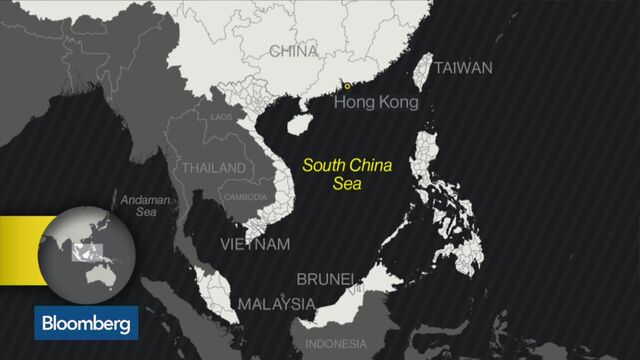by Nafeesa Syeed , Nick Wadhams , and David Tweed
-
President-elect says China ‘steals’ unmanned vessel from sea
-
China’s foreign ministry: Militaries in touch to handle case

Defense Department Says China Seized U.S. Navy Vehicle
“China steals United States Navy research drone in international waters -- rips it out of water and takes it to China in unprecedented act,” Trump wrote Saturday in a Twitter post. In an earlier tweet, Trump misspelled the word as “unpresidented.”
The tweet was sent hours after the Chinese government said it has been in touch with the U.S. military about the incident.
“China and the U.S. are using their military channels to properly handle this case,” China’s foreign ministry said in a statement sent to Bloomberg on Saturday, without elaborating further. Earlier, the Global Times -- a newspaper affiliated with the Communist Party -- cited a Chinese military official saying the drone was taken during a security check and the incident would likely be “resolved successfully.”
A Chinese naval ship unlawfully seized the small unmanned vehicle Thursday while the USNS Bowditch, a U.S. Navy survey ship, was pick up the drone in a routine operation 50 nautical miles northwest of Subic Bay in the Philippines, according to a Defense Department statement.
While the motive remains unclear, the move threatened to exacerbate tensions between the U.S. and China at a time when policy in Washington is becoming uncertain. Trump has threatened higher tariffs on Chinese products and questioned the U.S.’s policy regarding Taiwan, which Beijing considers part of its territory.
‘Serious Test’
The seizure was “one of the most brazen actions that the PLA Navy has taken against U.S. Navy for a very long time,” said Ashley Townshend, research fellow at the U.S. studies center at the University of Sydney. “Against a background of rising tensions in the South China Sea and Trump’s increasingly hawkish comments on China policy, this incident will be a serious test for U.S.-China relations.”The unmanned underwater vehicle is an unclassified “ocean glider” system used around world to gather data on salinity, water temperature and sound speed, the Pentagon said.
“We call upon China to return our UUV immediately, and to comply with all of its obligations under international law," Pentagon spokesman Peter Cook said in a statement Friday.
The Bowditch, which belongs to the U.S. Military Sealift Command, was on a routine mission to retrieve the drones, according to the Department of Defense. The Bowditch made radio contact with the Chinese navy ship requesting the return of the vehicle, but the request was ignored, Cook said in the statement. He described the drone as a “sovereign immune vessel of the United States.”
Typically the drones operate under their own power. The Chinese vessel was about 500 yards from the Bowditch when it launched a small vessel to retrieve the drone, according a Defense Department official who spoke on condition of anonymity because those details hadn’t been publicly released.
“China is very sensitive about unmanned underwater vehicles because they can track our nuclear ballistic missile submarines fleet,” said retired Major General Xu Guangyu, a senior researcher at Beijing-based research group the China Arms Control and Disarmament Association. “If one from the Bowditch can be detected and even snatched by a Chinese naval ship, it shows it’s getting too close to the sensitive water areas.”
The nearest disputed area of the sea from the latest incident is Scarborough Shoal, about 150 nautical miles from Subic Bay. The last major confrontation between the U.S. and China similar to Thursday’s happened in 2013, when a Chinese vessel cut in front of the USS Cowpens guided-missile cruiser from a distance of 100 yards, an incident that then-U.S. Defense Secretary Chuck Hagel called “irresponsible.” The two sides have since sought to improve communications with the intent of avoiding such incidents.
Militarizing Reefs
China claims more than 80 percent of the South China Sea, where it has constructed artificial reefs and built up its military presence. On Thursday, China confirmed a report that it had installed weapons on the reefs it has developed in the sea, with a Defense Ministry statement describing the arms as a “slingshot” to fend off threats, according to the New York Times.The U.S. has continued to conduct what it calls freedom-of-navigation exercises, deploying vessels through the sea to underscore the right to free passage in international waters. China calls the moves provocative and a challenge to its territorial claims. Other nations in the region claim parts of the same waters, a thriving fishing zone through which more than $5 trillion of trade passes each year.
The rising tensions at sea come as the political balance in Southeast Asia over the disputed waters may be changing. While the Philippines won a favorable ruling from an international arbitration court on its territorial dispute with China that was initiated by his predecessor, President Rodrigo Duterte said at a televised briefing in Davao City Friday that he would set aside that finding as he attempts to work with China.“It’s entirely possible that the Chinese are beginning to look for ways to send signals to the new administration that they are not going to be pushed around when it comes to the U.S. role in Asia, whether it’s Taiwan or the South China Sea,” said Michael Fuchs, deputy assistant secretary of state for East Asian and Pacific Affairs from 2013 to 2016 and now a senior fellow at the Center for American Progress.












